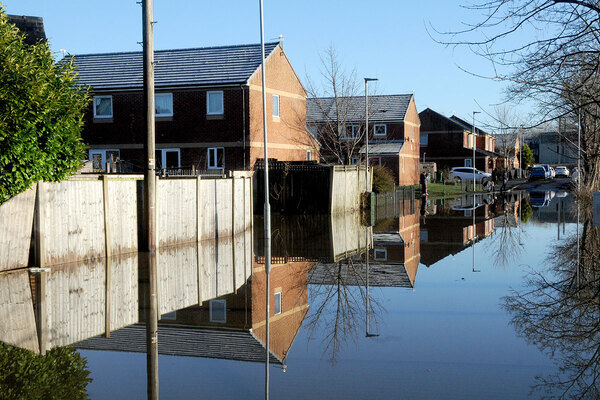The 10,000-kilowatt elephant in the room
Given the UK’s decarbonisation agenda is essentially an electrification strategy, we need to have a serious conversation about the price and supply of electricity in the UK, writes Nicholas Harrington, a researcher at the UK Collaborative Centre for Housing Evidence

It is clear to all involved that the UK faces a considerable challenge in decarbonising its domestic heating. Domestic heating of space and water accounts for about 15% of all greenhouse gas emissions. The central strategy is for homes to move away from gas heating and towards net zero heating technologies such as heat pumps, which will ultimately be powered by renewable, non-polluting energy sources.
Put simply, the UK’s net zero future is an electrified society: electric heating, electric cooking, electric cars and public transport.
Given the UK’s decarbonisation agenda is essentially an electrification strategy, it is somewhat surprising that so much attention is paid to the deployment of heat pumps and the process of retrofitting leaky homes, but so little to the price and supply of electricity.
The challenge of decarbonising the UK’s domestic heating sector can be described as follows. In the best-case scenario, we have a well-insulated home with excellent energy and thermal efficiency. All this homeowner needs to do is call a heat pump installer and around two weeks and £12,000 to £15,000 later, they will have a wonderfully cosy home and save money on their heating bills.
The middle-case scenario is a home that might today be classified as having an Energy Performance Certificate (EPC) rating of C, D, or E. This homeowner, however, is faced with something of a dilemma. Either they spend £12,000 to £15,000 on a heat pump and installation and then pay a little more for their heating bills, or they might spend up to £25,000 to improve the fabric of their home alongside the installation of the heat pump to ensure their heating costs remain the same.
Turning now to the worst-case scenario: we have a profoundly leaky home that loses heat extremely quickly and is either of low property value or heritage/conservation restricted. This homeowner won’t proceed with the necessary retrofit because there is no business case to do so, or they are otherwise prohibited by local authorities. Replacing gas heating in such a home with a heat pump may mean doubling, perhaps even tripling, the annual energy bill.
As noted by the Chartered Institute of Housing, due to the risk of fuel poverty, many housing associations are opting for a fabric-first approach – retrofitting where required first – rather than installing heat pumps.
At the end of the day, the difference between the best and worst-case scenarios is determined by the high cost of electricity relative to gas. In the United Kingdom, a kilowatt hour of natural gas costs around 10p, whereas a kilowatt hour of electricity costs almost 40p.
This 4:1 ratio in the price of electricity to gas is, fundamentally, the structural condition that makes our shift towards net zero heating technologies so difficult. New country comparison research illustrates the correlation between a high electricity-to-gas price ratio and low uptake of heat pumps.
Although there are many other factors at play, it is relevant that out of the four nations included in figure one, Sweden has the highest number of heat pumps per 100,000 population (24,390), Switzerland the second highest (10,500), Germany the third highest (4,300), and the UK the lowest (1,480) – the penetration of heat pumps appears to track the electricity-to-gas price ratio.
It is almost as though the problem is so obvious that many researchers and policymakers have taken it for granted. We need to have a serious conversation about the price and supply of electricity in the UK.
Let’s engage in a thought experiment. Imagine electricity was free, green and abundant. If electricity was free, green and abundant, we wouldn’t need heat pumps and we wouldn’t need to retrofit any of our buildings. We could simply install fan-forced or radiant electric heating in every home and the UK’s domestic sector would instantaneously become completely decarbonised.
Critically, however, as it stands electricity is not free, not green and not abundant. Presently, the UK pays more for electricity than anywhere in Europe, only 47% of the UK’s electricity comes from zero-carbon sources, and the UK’s energy grid requires a considerable upgrade to meet increasing demand.
Property data firm Outra estimated it will cost £156bn to bring all homes in the UK to an EPC rating of C. Given, however, that many EPC C-rated homes would still require additional fabric and heating system upgrades to ensure heat pumps perform economically, the Outra estimate may need revising. If, for example, half the homes in the UK required an average of £18,000 in retrofit to improve energy and thermal efficiency, the total cost of such an undertaking would be around £237.6bn.
Given we are at the bottom of an extensive uphill struggle to decarbonise domestic heating, it is the perfect time to ask how far an investment of almost a quarter of a trillion pounds would get us toward the ideal of free, green and abundant electricity. Perhaps we don’t get all the way, but surely meaningful public investment in the generation and supply of renewable energy could make electricity affordable, green and abundant.
“This 4:1 ratio in the price of electricity to gas is, fundamentally, the structural condition that makes our shift towards net zero heating technologies so difficult”
If this approach were to be taken, the decarbonised future – ie the electrified society that underwrites any net zero strategy – becomes far easier and far more likely to transpire.
If the present state of domestic politics renders public investment in the generation and supply of affordable, green and abundant electricity beyond the scope of the possible, at the very least we must find a way of lowering the electricity-to-gas price ratio in the United Kingdom. Nesta argues that electricity prices ought to be “no more than 2.5 times the cost of gas”.
The Regulatory Assistance Project suggests one way of lowering the ratio would be to shift the ‘green levies’ that currently constitute around 23% of the total cost of electricity onto gas – or simply waive the levy cost for homeowners running heat pumps. The issue with the first proposal is two-fold. First, since 38.5% of electricity is produced by burning gas, making gas more expensive may not make electricity cheaper. Second, increasing the cost of gas would immediately impact the 3.26 million UK households in fuel poverty.
Equally, proposals for a carbon tax – a policy that would more appropriately shift decarbonisation costs onto fossil fuels – have long been dogged by claims they are “regressive, hitting low-income households disproportionately”. These dilemmas reveal an urgent need to think seriously about how to bring down the price of electricity in a fair, credibl, and acceptable way.
In the final analysis, the transition to net zero is going to cost billions and billions of pounds – of that, there can be no doubt. The only serious question, therefore, is what we are going to spend that money on: retrofitting 13.2 million homes to get them heat pump ready, or the 10,000-kilowatt elephant in the room?
Sign up to the Retrofit and Strategic Asset Management Summit

Learn how to develop long-term and joined-up strategies that simultaneously tackle energy efficiency, damp and mould, Decent Homes, building safety and fuel poverty.
Join over 500 sector leaders to ensure your capital investments go further and deliver healthy, warm and safe homes for all tenants and residents.







